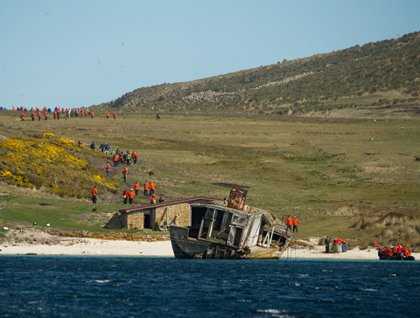New Island and Carcass Island were to be our introduction to the Falkland Islands, examples of the historic British farming settlements that have been in continuous operation since the mid-nineteenth century. These are BC rather than AC communities, to use a local classification, that is, before rather than After the Conflict of 1982 in their way-of-life.
New Island is the most westerly inhabited island in the Falklands archipelago and was for many years a refuge for British and American whalers. After breakfast, in fine, sunny, and characteristically windy conditions we carried out a beach landing by Zodiac with the object of walking across the island to visit a large colony of rockhopper penguins and black-browed albatross. A wreck in the bay was the remains of Glengowan, a ship from Swansea that caught fire on its maiden voyage in 1895 carrying Welsh coal to San Francisco. At the beachhead the island’s Nature Conservation Trust has a small but interesting exhibition on local history, flora, and fauna. The building bears the name of Charles Barnard, a New England sealer who was marooned on the island with four companions for 18 months (1813-14) before being rescued by an English whaling ship. The Barnard Memorial Museum is built on the site of the hut used by the five unfortunates. Sheep on New Island are now confined to a restricted area so that the tussock grass can regenerate. Upland geese, striated caracaras, and skuas were much in evidence.
Over lunch we repositioned to Carcass Island where Rob McGill and his family still farm sheep and a few cattle. The island takes its name from the visit of HMS Carcass in 1766, surveying the island’s coastline the following year. This was an opportunity for graded hikes, the longest one following a ridge trail that afforded views of both sides of the island in wonderful visibility. Free of cats, rats, and mice the island supports a healthy population of ground-nesting birds such as Cobb’s wrens, black-throated finches, and Falkland thrushes. A highlight of the afternoon for everyone was an open invitation to tea in the McGill family home, nestled in a protective thicket of introduced species: Monterey cypress, flax and cabbage palms from New Zealand, and an impressively tall box hedge.







